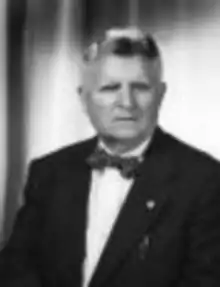Carl Clarence Kiess
Carl Clarence Kiess (October 18, 1887 – October 16, 1967) was an American astronomer. His main contributions was in the study of solar and stellar spectra.[1]

Kiess was born in Fort Wayne, Indiana.[1] He earned a BA in astronomy from Indiana University in 1910 and a PhD from the University of California, Berkeley in 1913.[1] After teaching at the University of Missouri, Pomona College, and the University of Michigan, Kiess took a position at the National Bureau of Standards in 1917.[1] He retired from the bureau in 1957.[1]
While working at the Lick Observatory on July 6, 1911, Kiess discovered comet C/1911 N1, which was named after him. A lunar crater and the asteroid 1788 were also named after him.
Kiess was a recipient of an honorary doctorate degree from the Indiana University.[2]
References
- Hockey, Thomas (2009). The Biographical Encyclopedia of Astronomers. Springer Publishing. ISBN 978-0-387-31022-0. Retrieved August 22, 2012.
- "University Honors & Awards". Indiana University. Archived from the original on April 3, 2013. Retrieved March 1, 2013.